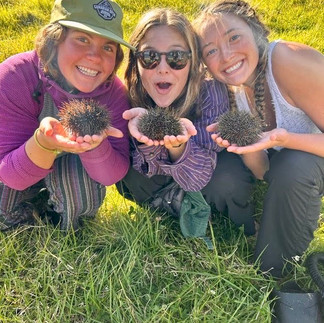Divergent Paths in Conservation: Maori Co-governance and Native American Genocide
- Ella Heydenfeldt
- Jan 15, 2024
- 4 min read
Pictures from Wildlands
My Wildlands Fields Studies program in New Zealand, studying island ecosystems, allowed me to explore and contrast sustainable practices and conservation efforts in New Zealand and the United States.
We commenced the program in Northern New Zealand's Bay of Islands, where we delved into traditional Māori culture, history, and practices through the guidance of TriOceans, an organization dedicated to marine health education and outreach.
TriOceans introduced me to pivotal concepts like Iwi and hapū, illuminating the structure of local Māori tribes composed of different families (hapū's), each with its elected chief. The practice of rāhuis, protective measures imposed on endangered areas or species due to human activities, shed light on a co-governance system involving the Iwi, elders, and a designated protector (kaitiaki.) A rāhui may be placed on anything that a member of the tribe brings to the attention of the elders, then, after careful review, may be established. A small group or Kaitiaki is elected to keep up with the actions that must be taken to conserve said area or species. After the subject of the rāhui recovers, the rāhui is removed, and standard activities are allowed to resume once more. Rāhuis, established based on an honor system, have proven effective in conserving ecosystems by halting activities such as harvesting kina or fishing in specific areas.
In addition, government agencies in New Zealand may impose a rāhui over sensitive areas and may support traditional rāhuis established. Rāhuis do not have legal standing, but they do put pressure on the government and local councils to enact change. Furthermore, it is seen as taboo and extremely disrespectful to go against a rāhui.
What I found in New Zealand was a system of co-governance among the native people and the government. A system that supports the enactment of sustainability practices in a pretty effective way. I found communities that successfully work within the honor system.
However, the United States works with no such system. Our complex, large government that represents 331.9 million people, compared to the 5.1 million people in Aotearoa, New Zealand, has no quick shortcut in conserving an endangered species or land. The bureaucratic hurdles in passing acts and laws are not only time-consuming but also financially burdensome.
Moreover, this disparity extends beyond contemporary governmental practices, delving into the historical context of colonization. In New Zealand, I studied the history of the Māori people and their encounter with British colonial forces, experiencing a tale distinct from the genocide faced by Native Americans in the United States.
The Māori people, Polynesian navigators who arrived in New Zealand around 1250 CE, encountered European explorers in the late 18th century. Initial interactions were often characterized by trade and cultural exchange. However, as European settlers arrived in greater numbers, tensions escalated.
Unlike the devastating impact of diseases on Native American populations, the Māori were not as severely affected due to geographic isolation. Furthermore, the Māori were a warrior people known to be cannibals, and stories of their brutal acts in battle inspired fear in the British. The British tried and failed to eradicate the Māori and were forced, instead, to create and sign treaties with the native peoples. The signing of the Treaty of Waitangi in 1840 between the British Crown and Māori chiefs marked a turning point. Despite promises of protection and partnership, the treaty's implementation led to significant land confiscation and cultural marginalization, impacting the Māori way of life. However, a system of co-governance was established, and the Māori managed to retain a stronger sense of cultural identity despite the challenges posed by colonization. Efforts to revitalize the Māori language, traditions, and arts have played a crucial role in preserving their cultural heritage. The establishment of institutions like Te Wananga o Aotearoa, focused on Māori education, reflects a resilient commitment to cultural survival.
In contrast, the arrival of Europeans in North America had catastrophic consequences for Native American populations. The introduction of diseases such as smallpox, along with forced relocations, led to a dramatic decline in Native American numbers. The colonization process was intertwined with deliberate policies of genocide, including the forced removal of tribes from ancestral lands, massacres, and the intentional destruction of cultural practices. Government-backed policies, such as the Indian Removal Act of 1830 and the Trail of Tears, left a devastating legacy. The widespread loss of land, resources, and lives inflicted a profound and lasting trauma on Native American communities. Forced assimilation through boarding schools, the suppression of indigenous languages, and the undermining of traditional practices have eroded cultural continuity. Despite ongoing efforts to reclaim and revitalize Native American languages and traditions, the scars of genocide and cultural disruption persist.
What has all of this led to? The traditional knowledge and land management practices of Native Americans have been largely lost to history. Indigenous peoples of North America have limited power and have been silenced for decades. While the Māori in New Zealand have managed to safeguard their cultural heritage through resilience and co-governance, Native Americans in the United States face ongoing challenges due to the historical atrocities they endured. The loss of traditional knowledge and the silencing of indigenous voices remain poignant legacies.










Comments